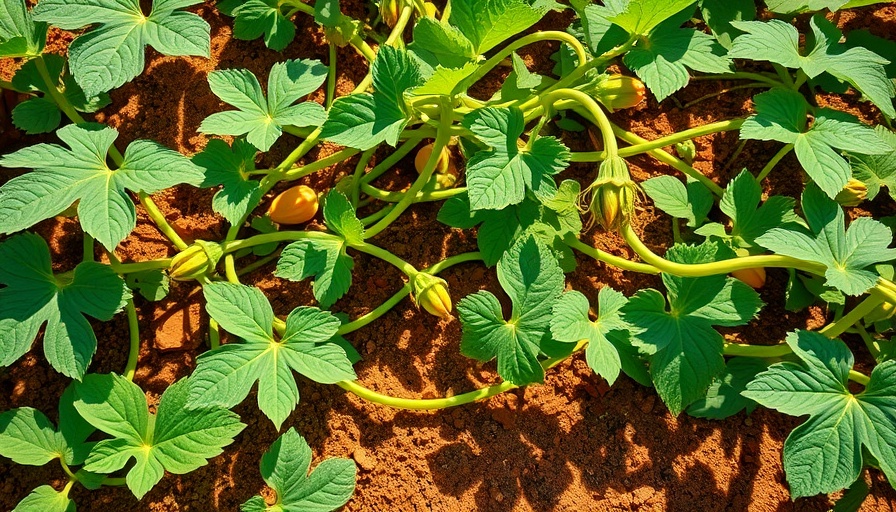
Understanding the Basics of Pumpkin Vines
Pumpkins are not only a delicious treat but also a fun challenge for gardening enthusiasts. Growing these vibrant fruits can transform your backyard into a lively space of green, gold, and orange. However, understanding their growth habits is essential to cultivating a healthy crop. Pumpkins sprout from a main vine that emerges from the roots, and as they grow, secondary vines, known as runners, develop. These runners can produce secondary roots but may detract nutrients from the main vine if not managed correctly. This is why regular trimming is crucial for ensuring that nutrients are focused on developing pumpkins instead of driving numerous vines uncontrolled.
The Importance of Proper Trimming
While trimming pumpkin vines may not seem necessary at first, it’s a straightforward approach that can lead to increased yield and healthier plants. By pricking back certain vines and eliminating weak or unnecessary growth, gardeners can promote better airflow and sunlight penetration. This is particularly beneficial in reducing diseases associated with damp leaves, breathing life into your pumpkin patches. Moreover, it is an opportunity to enhance the size and quality of the remaining pumpkins, as the plant can redirect its energy efficiently.
Key Timing: When to Prune Your Vines
The timing of trimming is just as crucial as the act itself. Gardeners are encouraged to wait until their pumpkin plants reach at least 10 to 15 feet in length and have established a few fruits. Larger varieties benefit from having two to five well-formed fruits, while smaller cultivars may need to have 10 to 12 small gourds. This waiting period allows the plant to focus its resources on producing fewer, but healthier, fruits, ensuring a bountiful harvest come autumn.
How to Effectively Trim Your Pumpkin Vines
Start by inspecting your pumpkin plant for the main and secondary vines. Familiarizing yourself with this anatomy will aid in understanding what needs to be trimmed. Begin by removing any tertiary runners early on to prevent them from diverting valuable nutrients. When trimming, make sure to use sharp, clean garden shears to avoid any potential diseases contaminating the remaining plant parts. Cut away any dead or disease-affected leaves and keep the strongest runners that are closest to your pumpkins to promote their growth.
Pruning for Health: Reducing Risk of Disease
Regular pruning not only encourages better yields but also plays a crucial preventive role for diseases. As fruits develop and heat rises in the summer months, moisture can linger on leaves, leading to fungal infections if airflow is compromised. By employing strategic pruning, you can prevent the occurrence of leaf spots and other challenges. A clean gardening environment helps in reducing the chances of pests invading your garden, creating a healthier growing atmosphere.
Harnessing the Power of Community Gardening
In addition to individual efforts, being part of a local gardening community can be a tremendous resource. Sharing techniques and experiences among fellow gardeners allows for a diverse knowledge-base and support system. Whether you are swapping seedlings, engaging in group discussions, or even assisting each other with pruning tasks, these communal ties can enrich your gardening journey. Local resources often host workshops, providing invaluable tips for enthusiastic gardeners in urban and suburban areas alike.
Future Growth Trends in Home Gardening
As gardening gains popularity, there will likely be a rise in shared digital content discussing new techniques and sustainable growing practices. An emphasis on eco-friendly techniques will lead many to seek out varieties of pumpkins that are pest-resistant and climate-friendly. Engaging with resources that encourage this type of growth not only fosters healthier crops but enriches your experience as a gardener.
As you embrace the art of pruning pumpkin vines, reflect upon the harmony of nurturing growth in both your surroundings and your community. It’s not only about growing crops but also about entrenching oneself in sustainable practices for a better future.
While gardening may initially appear straightforward, the intricacies of nurturing plants bring forth a unique form of self-discovery and confidence. So, grab your shears, embrace the process of learning, and cultivate a thriving pumpkin garden that could provide not just fresh produce but also foster deeper connections within your community.
For more tips on maximizing your gardening efforts and ensuring a fruitful harvest, consider exploring local gardening workshops or community classes that enhance your knowledge as a dedicated gardener!
 Add Row
Add Row  Add
Add 




Write A Comment